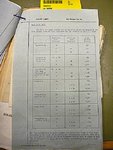- Thread starter
- #61
DarrenW
Staff Sergeant
F6F - agreed, plus not a long range bird
By whose standards? I think having a 1000+ mile range qualifies it as being a rather long range single-seat fighter, don't you?
Follow along with the video below to see how to install our site as a web app on your home screen.
Note: This feature may not be available in some browsers.
Ad: This forum contains affiliate links to products on Amazon and eBay. More information in Terms and rules
F6F - agreed, plus not a long range bird
Not from land.
It took a while to get enough carriers to to be able to put carrier aircraft wherever and whenever the Navy wanted.
How much closer were Army fighters based to the action in 1943? And I disagree that one must discount external tanks when considering the effective range of a fighter. They must have been a viable means of extending the radius of an aircraft or they wouldn't have carried them in the first place.
Hellcat can fly 955 miles at 160mph attitude not given but from pilots manual that maybe 1500ft.
What is the suggestion that the Hellcat would cruise at 1500 feet based on, is that a joke?
From the start, it was one of the most successful recon planes of the war.I do agree fully with your remarks concerning the Spitfire. Since when was it ever considered useful for long range anything????
The pilot's manual I have gives a different story for max range:
Grumman F6F (3-5) Pilot's Manual
Excerpt:
View attachment 489183
As you can see the range with 400 gallons of fuel (at an altitude of 25,000ft and flying 283 mph) was 935 statute miles. I'm also pretty certain that most combat missions were flown well above the 1,500ft altitude (a Hellcat pilot once told me that most of his combat flying was between 10,000-20,000 feet). I hope you don't think that the pilots who flew these machines were suicidal?
The link you provided shows a combat radius for the Hellcat with a drop tank at 385 statute miles, and close to 140 statute miles without, just to compare apples to apples. And that is with everything taken into consideration such as take-off, rendezvous, climb to 15,000ft, cruise out at 200 mph, fight for 20 minutes (in and out of WEP) and return with 60 minutes of fuel in the tanks (using US Navy's F-1 formula).
How do you think your Spit would do under similar circumstances?
And to convince you that I'm being totally impartial with my viewpoint (as well as being open to your opinion), I've taken the liberty of changing my vote in this thread from the F6F-3 to the "Jug".....
I do agree fully with your remarks concerning the Spitfire. Since when was it ever considered useful for long range anything????
I don't get the notion that external fuel doesn't matter. During WW2 escort fighters in general would fly out burning the external fuel and also the fuel in tanks which affected maneuverability first, i.e. the fuselage tank on the P-51 or P-40 for example. When they arrived at the mid-way point their external tanks would be close to empty, ideally. So the route back does have to be on internal fuel in most cases but depending on when you expect to face combat* you should be flying back to base with close to full internal fuel. Only missing whatever you burned in combat.
So the metric of "internal fuel only" combat radius seems a bit disingenuous to me.
I do agree fully with your remarks concerning the Spitfire. Since when was it ever considered useful for long range anything????
From the start, it was one of the most successful recon planes of the war.
View attachment 489392
There was much that could have been done to improve the range of the spitfires internal fuel, but this would have taken it up to being on par with a P-47 and the USA already had P-47s while the UK had Mustangs too.

You found it before I did. I find the bottom paragraph of interest.1940 - long rage recon
1942 - fighter that can be deployed from UK to Gibraltar, then from Gib to Malta via aircraft carriers, included a 170 imp gal drop tank and 29 imp gal rear fuselage tank
1943 - LR fighter modified in the USA
late 1944 - LR fighter modified in the UK (see the doc atached)
This is from September of 1944. Every single bit is that concerns Spitfires is feasible in winter of 1942/43, plus the leading edge tanks (+25 imp gals, as on the Spit VIII), plus the under-seat tanks (used on some recon versions) - much earlier than LR Mustangs. Alas, the things were dictated by doctrine, not by capabilities of aircraft. Picture kindly provided by Glider IIRC:
View attachment 489394
The metric starts with the dropping of the fuel tanks. Say for our F6F you can fit two 150 gallon tanks, the problem is can you get in further than you can get out?
1943 - LR fighter modified in the USA
late 1944 - LR fighter modified in the UK (see the doc atached)
Alas, the things were dictated by doctrine, not by capabilities of aircraft.
Without a fleet of bombers why would you make an ultra long range fighter in Europe? You may find that someone wants to fight with you for more than 20 mins or not let you cruise home at your most economical setting.I see a lot of modifying going on here....